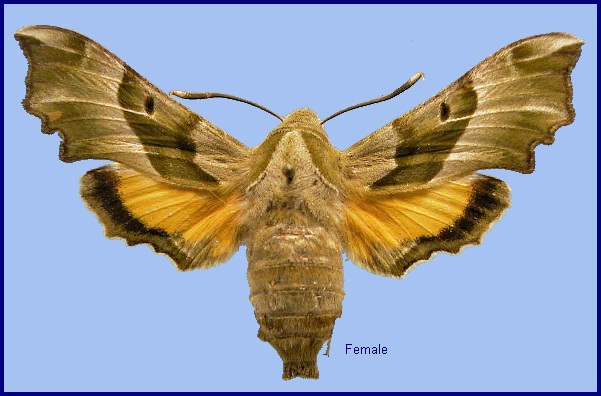
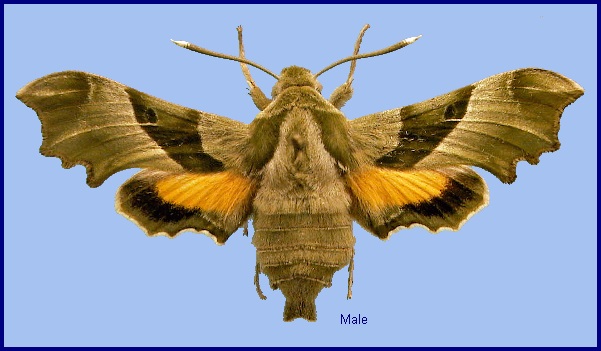
Sphynx proserpina Pallas, 1772, Spic. Zool. (1) 9: 26. Type locality: Germany, Frankfurt am Main.
Synonym. Sphynx proserpina Pallas, 1772.
Synonym. Sphinx oenotherae [Denis & Schiffermüller], 1775, Ankündung syst. Werkes Schmett. Wienergegend: 43.
Synonym. Sphinx schiffermilleri Fuessly, 1779, Magazin Liebh. Ent. 2: 69.
Synonym. Sphinx francofurtana Fabricius, 1781.
Synonym. Proserpinus aenotheroides Butler, 1876, Proc. zool. Soc. Lond. 1875: 621.
Synonym. Pterogon proserpina maxima Grum-Grshimailo, 1887.
Synonym. Pterogon proserpina var. japetus Grum-Grshimailo, 1890, in Romanoff, Mém. Lépid. 4: 513.
Synonym. Proserpinus proserpina brunnea Geest, 1903.
Synonym. Proserpinus proserpina attenuata Schultz, 1904.
Synonym. Proserpinus proserpina grisea Rebel, 1910.
Synonym. Proserpinus proserpina infumata (Closs, 1911).
Synonym. Proserpinus proserpina schmidti Schmidt, 1914.
Synonym. Proserpinus proserpina gigas Oberthür, 1922, Etud. Lepid. comp. 19: 128.
Note. 'Subspecies' gigas and japetus are not tenable as there is no consistent character which can be used to separate them from subsp. proserpina.
Wingspan: 36--60mm.; most about 46mm. Forewing outer margin deeply sinuate below apex, produced at ends of M3, Cu1 and 1A+2A. Labial palps shorter than Proserpina gaurae. Abdomen underside reddish-orange with white scaling along the posterior margins of the sternites. Difficult to confuse with any other sphingid from the region. Although highly variable in size, colour variation tends to be minimal, being confined to the primary ground coloration, which is normally shades of green: f. schmidti Schmidt has yellow-grey forewings and grey hindwings; f. brunnea Geest has a pale 'leather' coloration with a reddish median band; f. grisea Rebel has the green coloration entirely replaced by grey.
In the male genitalia, gnathos rather longer and slender than Proserpinus clarkiae. Harpe short, often dilated at end, sometimes gradually narrowed to a point as Proserpinus gaurae.

A local species, often disappearing from a locality for a number of years, but appearing in another. Mainly found along the edges of woods and scrub, especially by streams and rivers.
Few adults are found by searching due to their predominantly green coloration combined with their preference for resting among low vegetation at the base of the plants. Flies for only a short period each day, usually at dawn and dusk (Rondou, 1903), although individuals have been seen in sunlight at midday (Pittaway, 1993). Attracted to strong-smelling and blue flowers.
China: 5.vi (Jingo He/river). Russia: 28.v (Altai); vii (Siberia).
OVUM: Green, almost spherical (1.0 x 1.1mm), shiny and smooth. Laid singly on the under-surface of leaves, close to the flower-heads, often more than one to a plant.
LARVA: Full-fed 60--70mm. Dichromatic: green or brown.
Matt green when young with a yellow dorso-lateral line, a yellow head and a matt yellow spot supplanting the horn. Spiracles black, ringed with yellow. At this stage it feeds quite openly, either on the upperside of a leaf or, when on Oenothera, on the flowers. Growth is slow at first, but speeds up considerably on reaching the fifth instar, at which stage most individuals leave the hostplant to hide during the day, either at its base or somewhere nearby. The majority will now have acquired their final coloration: dorsal surface brown with black dots; sides and ventral surface buff, cris-crossed by a network of fine, dark lines. Spiracles brown, each set in a brown spot elongated into an oblique streak. Head brown; posterior button (in place of horn) yellow or orange, brown-centred and black-ringed. A few, however, remain primarily green throughout the larval stage but still bear the standard pattern.
Always found singly but often locally common. When on the move, the larva creeps along with a rather hesitant, jerky motion.
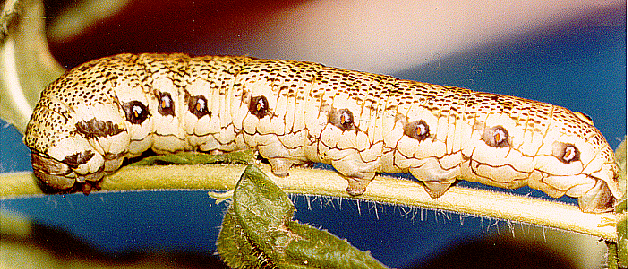
PUPA: 25--30mm. Reddish brown with darker head and abdomen. Cremaster broad basally, flattened dorso-ventrally. With two prominent head tubercles; proboscis only slightly keeled. Very similar in shape to that of Daphnis but much smaller. Formed in a loosely spun cocoon among debris on the ground. The overwintering stage.
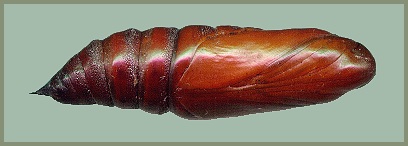
Larval hostplants. Unknown in China, but elsewhere usually on species of Epilobium, with occasional records on Lythrum and Oenothera.
Unknown for the region.
China: Xinjiang (Jingo He/river, 30km west of Shihezi); west Xizang/Tibet.
Russia: Altai (Rebrikha village, 53°05'12.6"N, 82°22'32.1"E, 28.v.2022); Siberia (Bogotola, Tomsk area; Karasuk; Omsk; Novosibirsk area; Elita, Krasnoyarsk area).
Chu & Wang (1982) report Proserpinus proserpina from southern Xizang/Tibet (Nyalam, 2250m), well outside the normal range of this species. This is probably a mislabelled specimen from farther north (?Qinghai), but this requires further investigation.
Occurs throughout central and southern Europe, east through Russia as far as Krasnoyarsk (Danner et al., 1998; Maksimov et al., 2022) and the Russian Altai (Davydov et al., 2023). Also east from Turkey and Lebanon through northern Iraq, northern Iran, southern Turkmenistan and Uzbekistan, to the Pamir Mountains, Tian Shan, eastern Afghanistan (Pittaway, 1993) and west Xizang/Tibet (Chu & Wang, 1980); thence northeast through eastern Kazakhstan to western Xinjiang. Also present in the Atlas Mountains of northwest Africa.
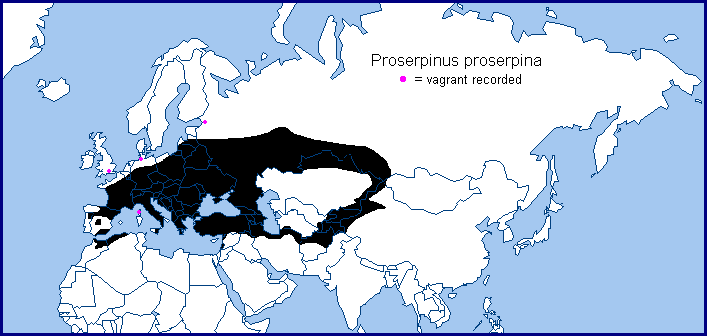
Holarctic; western Palaearctic region. Pleistocene refuge: Polycentric -- Atlantomediterranean/Mauritanian and Pontomediterranean subsections of the Mediterranean refuge, as well as the Turkestan refuge.
 Return to Sphingidae of the Eastern Palaearctic species list
Return to Sphingidae of the Eastern Palaearctic species list